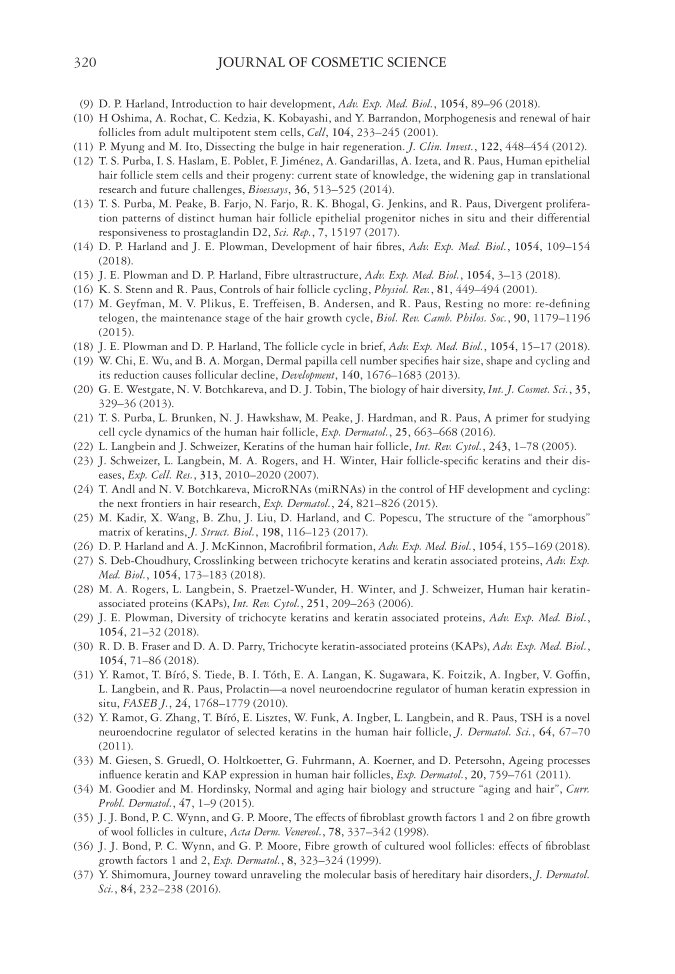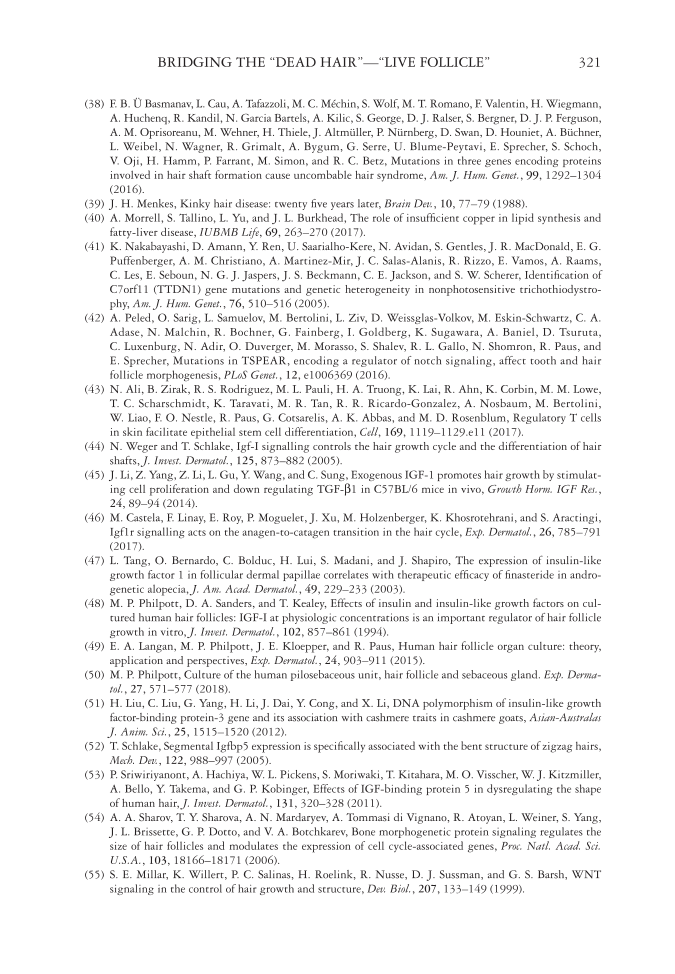JOURNAL OF COSMETIC SCIENCE 320 (9) D. P. Harland, Introduction to hair development, Adv. Exp. Med. Biol., 1054, 89–96 (2018). (10) H Oshima, A. Rochat, C. Kedzia, K. Kobayashi, and Y. Barrandon, Morphogenesis and renewal of hair follicles from adult multipotent stem cells, Cell, 104, 233–245 (2001). (11) P. Myung and M. Ito, Dissecting the bulge in hair regeneration. J. Clin. Invest., 122, 448–454 (2012). (12) T. S. Purba, I. S. Haslam, E. Poblet, F. Jiménez, A. Gandarillas, A. Izeta, and R. Paus, Human epithelial hair follicle stem cells and their progeny: current state of knowledge, the widening gap in translational research and future challenges, Bioessays, 36, 513–525 (2014). (13) T. S. Purba, M. Peake, B. Farjo, N. Farjo, R. K. Bhogal, G. Jenkins, and R. Paus, Divergent prolifera- tion patterns of distinct human hair follicle epithelial progenitor niches in situ and their differential responsiveness to prostaglandin D2, Sci. Rep., 7, 15197 (2017). (14) D. P. Harland and J. E. Plowman, Development of hair fi bres, Adv. Exp. Med. Biol., 1054, 109–154 (2018). (15) J. E. Plowman and D. P. Harland, Fibre ultrastructure, Adv. Exp. Med. Biol., 1054, 3–13 (2018). (16) K. S. Stenn and R. Paus, Controls of hair follicle cycling, Physiol. Rev., 81, 449–494 (2001). (17) M. Geyfman, M. V. Plikus, E. Treffeisen, B. Andersen, and R. Paus, Resting no more: re-defi ning telogen, the maintenance stage of the hair growth cycle, Biol. Rev. Camb. Philos. Soc., 90, 1179–1196 (2015). (18) J. E. Plowman and D. P. Harland, The follicle cycle in brief, Adv. Exp. Med. Biol., 1054, 15–17 (2018). (19) W. Chi, E. Wu, and B. A. Morgan, Dermal papilla cell number specifi es hair size, shape and cycling and its reduction causes follicular decline, Development, 140, 1676–1683 (2013). (20) G. E. Westgate, N. V. Botchkareva, and D. J. Tobin, The biology of hair diversity, Int. J. Cosmet. Sci., 35, 329–36 (2013). (21) T. S. Purba, L. Brunken, N. J. Hawkshaw, M. Peake, J. Hardman, and R. Paus, A primer for studying cell cycle dynamics of the human hair follicle, Exp. Dermatol., 25, 663–668 (2016). (22) L. Langbein and J. Schweizer, Keratins of the human hair follicle, Int. Rev. Cytol., 243, 1–78 (2005). (23) J. Schweizer, L. Langbein, M. A. Rogers, and H. Winter, Hair follicle-specifi c keratins and their dis- eases, Exp. Cell. Res., 313, 2010–2020 (2007). (24) T. Andl and N. V. Botchkareva, MicroRNAs (miRNAs) in the control of HF development and cycling: the next frontiers in hair research, Exp. Dermatol., 24, 821–826 (2015). (25) M. Kadir, X. Wang, B. Zhu, J. Liu, D. Harland, and C. Popescu, The structure of the “amorphous” matrix of keratins, J. Struct. Biol., 198, 116–123 (2017). (26) D. P. Harland and A. J. McKinnon, Macrofi bril formation, Adv. Exp. Med. Biol., 1054, 155–169 (2018). (27) S. Deb-Choudhury, Crosslinking between trichocyte keratins and keratin associated proteins, Adv. Exp. Med. Biol., 1054, 173–183 (2018). (28) M. A. Rogers, L. Langbein, S. Praetzel-Wunder, H. Winter, and J. Schweizer, Human hair keratin- associated proteins (KAPs), Int. Rev. Cytol., 251, 209–263 (2006). (29) J. E. Plowman, Diversity of trichocyte keratins and keratin associated proteins, Adv. Exp. Med. Biol., 1054, 21–32 (2018). (30) R. D. B. Fraser and D. A. D. Parry, Trichocyte keratin-associated proteins (KAPs), Adv. Exp. Med. Biol., 1054, 71–86 (2018). ( 31) Y. Ramot, T. Bíró, S. Tiede, B. I. Tóth, E. A. Langan, K. Sugawara, K. Foitzik, A. Ingber, V. Goffi n, L. Langbein, and R. Paus, Prolactin—a novel neuroendocrine regulator of human keratin expression in situ, FASEB J., 24, 1768–1779 (2010). (32) Y. Ramot, G. Zhang, T. Bíró, E. Lisztes, W. Funk, A. Ingber, L. Langbein, and R. Paus, TSH is a novel neuroendocrine regulator of selected keratins in the human hair follicle, J. Dermatol. Sci., 64, 67–70 (2011). (33) M . Giesen, S. Gruedl, O. Holtkoetter, G. Fuhrmann, A. Koerner, and D. Petersohn, Ageing processes infl uence keratin and KAP expression in human hair follicles, Exp. Dermatol., 20, 759–761 (2011). (34) M . Goodier and M. Hordinsky, Normal and aging hair biology and structure “aging and hair”, Curr. Probl. Dermatol., 47, 1–9 (2015). (35) J . J. Bond, P. C. Wynn, and G. P. Moore, The effects of fi broblast growth factors 1 and 2 on fi bre growth of wool follicles in culture, Acta Derm. Venereol., 78, 337–342 (1998). (36) J . J. Bond, P. C. Wynn, and G. P. Moore, Fibre growth of cultured wool follicles: effects of fi broblast growth factors 1 and 2, Exp. Dermatol., 8, 323–324 (1999). (37) Y . Shimomura, Journey toward unraveling the molecular basis of hereditary hair disorders, J. Dermatol. Sci., 84, 232–238 (2016).
BRIDGING THE “DEAD HAIR”—“LIVE FOLLICLE” 321 (38) F . B. Ü Basmanav, L. Cau, A. Tafazzoli, M. C. Méchin, S. Wolf, M. T. Romano, F. Valentin, H. Wiegmann, A. Huchenq, R. Kandil, N. Garcia Bartels, A. Kilic, S. George, D. J. Ralser, S. Bergner, D. J. P. Ferguson, A. M. Oprisoreanu, M. Wehner, H. Thiele, J. Altmüller, P. Nürnberg, D. Swan, D. Houniet, A. Büchner, L. Weibel, N. Wagner, R. Grimalt, A. Bygum, G. Serre, U. Blume-Peytavi, E. Sprecher, S. Schoch, V. Oji, H. Hamm, P. Farrant, M. Simon, and R. C. Betz, Mutations in three genes encoding proteins involved in hair shaft formation cause uncombable hair syndrome, Am. J. Hum. Genet., 99, 1292–1304 (2016). (39) J. H. Menkes, Kinky hair disease: twenty fi ve years later, Brain Dev., 10, 77–79 (1988). (40) A. Mor rell, S. Tallino, L. Yu, and J. L. Burkhead, The role of insuffi cient copper in lipid synthesis and fatty-liver disease, IUBMB Life, 69, 263–270 (2017). (41) K. Nak abayashi, D. Amann, Y. Ren, U. Saarialho-Kere, N. Avidan, S. Gentles, J. R. MacDonald, E. G. Puffenberger, A. M. Christiano, A. Martinez-Mir, J. C. Salas-Alanis, R. Rizzo, E. Vamos, A. Raams, C. Les, E. Seboun, N. G. J. Jaspers, J. S. Beckmann, C. E. Jackson, and S. W. Scherer, Identifi cation of C7orf11 (TTDN1) gene mutations and genetic heterogeneity in nonphotosensitive trichothiodystro- phy, Am. J. Hum. Genet., 76, 510–516 (2005). (42) A. Pel ed, O. Sarig, L. Samuelov, M. Bertolini, L. Ziv, D. Weissglas-Volkov, M. Eskin-Schwartz, C. A. Adase, N. Malchin, R. Bochner, G. Fainberg, I. Goldberg, K. Sugawara, A. Baniel, D. Tsuruta, C. Luxenburg, N. Adir, O. Duverger, M. Morasso, S. Shalev, R. L. Gallo, N. Shomron, R. Paus, and E. Sprecher, Mutations in TSPEAR, encoding a regulator of notch signaling, affect tooth and hair follicle morphogenesis, PLoS Genet., 12, e1006369 (2016). (43) N. Ali , B. Zirak, R. S. Rodriguez, M. L. Pauli, H. A. Truong, K. Lai, R. Ahn, K. Corbin, M. M. Lowe, T. C. Scharschmidt, K. Taravati, M. R. Tan, R. R. Ricardo-Gonzalez, A. Nosbaum, M. Bertolini, W. Liao, F. O. Nestle, R. Paus, G. Cotsarelis, A. K. Abbas, and M. D. Rosenblum, Regulatory T cells in skin facilitate epithelial stem cell differentiation, Cell, 169, 1119–1129.e11 (2017). (44) N. Weg er and T. Schlake, Igf-I signalling controls the hair growth cycle and the differentiation of hair shafts, J. Invest. Dermatol., 125, 873–882 (2005). (45) J. Li, Z. Yang, Z. Li, L. Gu, Y. Wang, and C. Sung, Exogenous IGF-1 promotes hair growth by stimulat- ing cell proliferation and down regulating TGF-β1 in C57BL/6 mice in vivo, Growth Horm. IGF Res., 24, 89–94 (2014). (46) M. Caste la, F. Linay, E. Roy, P. Moguelet, J. Xu, M. Holzenberger, K. Khosrotehrani, and S. Aractingi, Igf1r signalling acts on the anagen-to-catagen transition in the hair cycle, Exp. Dermatol., 26, 785–791 (2017). (47) L. Tang, O. Bernardo, C. Bolduc, H. Lui, S. Madani, and J. Shapiro, The expression of insulin-like growth factor 1 in follicular dermal papillae correlates with therapeutic effi cacy of fi nasteride in andro- genetic alopecia, J. Am. Acad. Dermatol., 49, 229–233 (2003). (48) M. P. Ph ilpott, D. A. Sanders, and T. Kealey, Effects of insulin and insulin-like growth factors on cul- tured human hair follicles: IGF-I at physiologic concentrations is an important regulator of hair follicle growth in vitro, J. Invest. Dermatol., 102, 857–861 (1994). (49) E. A. La ngan, M. P. Philpott, J. E. Kloepper, and R. Paus, Human hair follicle organ culture: theory, application and perspectives, Exp. Dermatol., 24, 903–911 (2015). (50) M. P. Ph ilpott, Culture of the human pilosebaceous unit, hair follicle and sebaceous gland. Exp. Derma- tol., 27, 571–577 (2018). (51) H. Liu, C. Liu, G. Yang, H. Li, J. Dai, Y. Cong, and X. Li, DNA polymorphism of insulin-like growth factor-binding protein-3 gene and its association with cashmere traits in cashmere goats, Asian-Australas J. Anim. Sci., 25, 1515–1520 (2012). (52) T. Schla ke, Segmental Igfbp5 expression is specifi cally associated with the bent structure of zigzag hairs, Mech. Dev., 122, 988–997 (2005). (53) P. Sriwi riyanont, A. Hachiya, W. L. Pickens, S. Moriwaki, T. Kitahara, M. O. Visscher, W. J. Kitzmiller, A. Bello, Y. Takema, and G. P. Kobinger, Effects of IGF-binding protein 5 in dysregulating the shape of human hair, J. Invest. Dermatol., 131, 320–328 (2011). (54) A. A. Sh arov, T. Y. Sharova, A. N. Mardaryev, A. Tommasi di Vignano, R. Atoyan, L. Weiner, S. Yang, J. L. Brissette, G. P. Dotto, and V. A. Botchkarev, Bone morphogenetic protein signaling regulates the size of hair follicles and modulates the expression of cell cycle-associated genes, Proc. Natl. Acad. Sci. U.S.A., 103, 18166–18171 (2006). (55) S. E. Mi llar, K. Willert, P. C. Salinas, H. Roelink, R. Nusse, D. J. Sussman, and G. S. Barsh, WNT signaling in the control of hair growth and structure, Dev. Biol., 207, 133–149 (1999).
Purchased for the exclusive use of nofirst nolast (unknown) From: SCC Media Library & Resource Center (library.scconline.org)









































































































